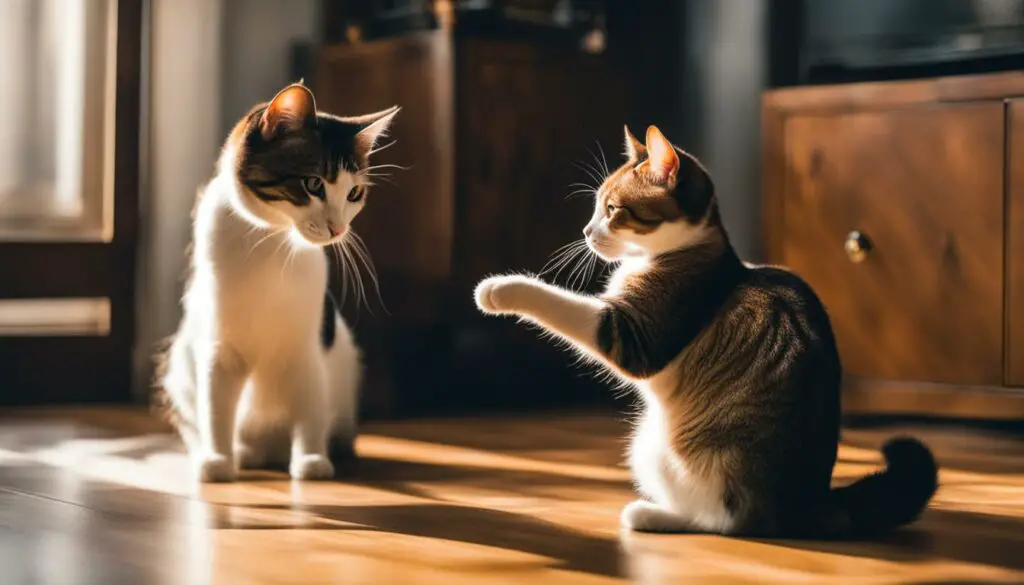Cats slapping one another is a normal behavior, but it can occur for a variety of reasons. To determine why cats swat each other, it’s important to look at their body language and behavior. Cats may swat each other as an invitation to play, to release pent-up hunting instincts, or as a form of communication when they are feeling unwell or in pain. Understanding the reasons behind their behavior can help you address any issues and prevent future conflicts.
Key Takeaways:
- Swatting between cats is a normal behavior but can occur for various reasons.
- Cats may swat each other to invite play, release hunting instincts, or as a form of communication.
- Understanding your cat’s behavior can help address any issues and prevent conflicts.
- Providing structured playtime and addressing any pain or discomfort can minimize swatting behavior.
- If aggression persists or escalates, seek professional help from a certified animal behaviorist or veterinary behaviorist.
Playful Swatting: Inviting Playful Behavior
Playful swatting is a common behavior among cats and is often a way for them to initiate play. Cats may engage in play fighting, which includes playful swatting, as a form of communication and social interaction. It is important to understand the body language and signals that cats exhibit during play to differentiate it from more aggressive behavior.
When cats playfully swat each other, they typically display forward whiskers, retracted claws, and a lack of hissing or growling. These are positive signs indicating that the swatting is part of a playful interaction. It is essential to observe their body language and ensure that both cats are comfortable and willing participants in the play session.
By recognizing the playful swatting behavior and understanding cat body language, you can encourage positive encounters and strengthen the bond between your cats. Providing interactive toys, encouraging supervised play sessions, and redirecting their play behavior can help fulfill their need for play without escalating into aggression.

Playful Swatting: Inviting Playful Behavior
Playful swatting is a normal behavior for cats and is often a way for them to invite play and interaction. Cats will engage in play fighting, which can include playful swatting, to communicate and bond with each other. Understanding the body language and signals that cats exhibit during play is essential to differentiate it from aggression.
During playful swatting, cats typically display forward whiskers, retracted claws, and a lack of hissing or growling. These behaviors indicate that the swatting is part of a playful interaction rather than aggressive behavior. It’s important to observe your cats and ensure they are both comfortable and willing participants in the play session.
To facilitate positive interactions, provide your cats with interactive toys, engage in supervised play sessions, and redirect their play behavior towards appropriate targets. Creating an engaging play environment can help fulfill their need for play while avoiding escalation into aggression.
Instinctive Swatting: Releasing Hunting Instincts
When cats swat each other, it may be due to their instinctive hunting behavior. Cats have a natural prey drive, and if they do not have an appropriate outlet for their hunting instincts, they may redirect their swatting behavior towards other cats or even their owners. This can lead to conflicts and tension in a multi-cat household.
To prevent excessive swatting, it is important to provide structured playtime for your cats. Interactive toys that mimic prey-like movements can help satisfy their hunting instincts. Set aside dedicated time each day for play sessions, engaging your cats with wand toys or other interactive toys that allow them to pounce, chase, and capture. This not only helps release their pent-up energy but also provides mental stimulation, which is essential for their overall well-being.
| Benefits of Structured Playtime: | How to Implement Structured Playtime: |
|---|---|
| • Reduces aggression and swatting behavior | • Set aside dedicated time each day |
| • Helps cats release pent-up energy | • Use interactive toys that mimic prey-like movements |
| • Provides mental stimulation | • Engage in play sessions with wand toys |
In addition to structured playtime, making sure your cats have access to appropriate scratching surfaces can also help redirect their hunting instincts. Scratching posts or cardboard scratchers provide an outlet for their natural need to scratch and helps prevent them from engaging in aggressive swatting behaviors. Providing a variety of scratching options in different locations throughout your home can further enrich their environment and reduce the likelihood of conflicts.
By understanding and addressing the instinctive swatting behavior of cats, you can create a harmonious environment where they can express their natural instincts in a positive and non-aggressive way.

Swatting due to Illness or Pain
Cats in pain or discomfort may exhibit swatting behavior towards other cats as a defensive response. This can occur when they are feeling unwell or experiencing chronic pain, which makes them more guarded and fearful of accidental injury from other pets. One common condition that may contribute to this behavior is arthritis, which is prevalent in older cats and can cause hidden pain. Regular veterinary check-ups and monitoring for signs of arthritis are crucial for early detection and management of this condition. In addition, providing appropriate joint supplements can help alleviate the pain-related aggression associated with swatting.
Regular veterinary check-ups and addressing any pain or discomfort in cats can reduce swatting behavior. Cats may swat at others if they are in pain or feeling unwell. Ensuring early detection and management of conditions like arthritis through examinations, x-rays, and joint supplements can help alleviate any pain-related aggression. (Source: First source)

When a cat is in pain, their instinct is to protect themselves. Swatting can be a defensive behavior to keep other cats at a safe distance. It is essential to provide a calm and stress-free environment for cats in pain or discomfort, where they feel secure and can recover without fear of further harm. By addressing their physical well-being and providing necessary pain management, you can help reduce swatting and promote a more harmonious coexistence among your cats.
If you suspect that your cat is experiencing pain or discomfort, it is crucial to consult with a veterinarian for a proper evaluation and treatment plan. Your veterinarian can assess your cat’s condition, provide appropriate pain relief options, and offer guidance on how to manage any aggression related to their discomfort. Remember, understanding and addressing the underlying physical causes of swatting behavior is key to creating a safe and peaceful environment for your cats.
Intercat Aggression: The Source of Swatting
Cats are known for their territorial nature, and intercat aggression can be a common cause of swatting behavior. When cats live in close quarters, conflicts can arise due to competition over resources and the need to establish territory. Understanding and addressing these underlying issues is essential for managing and minimizing swatting between cats.
The Role of Territorial Aggression
Territorial aggression occurs when cats feel threatened by the presence of other cats in their perceived territory. This can lead to swatting, hissing, growling, and even physical fights. Cats mark their territory through scent marking and leaving visual cues, such as scratching posts. When another cat encroaches on their territory, it can trigger territorial aggression and result in swatting behavior.
To mitigate territorial aggression, it is important to provide multiple resources for each cat, including litter boxes, food bowls, and resting areas. Ensuring that these resources are spread throughout the living space can help reduce competition and the likelihood of swatting. Additionally, creating vertical spaces such as cat trees and shelves can provide cats with more opportunities to establish their own territory and retreat when needed.
Importance of Cat Socialization
Socialization plays a vital role in preventing intercat aggression and swatting. Properly socialized cats are more likely to coexist peacefully and engage in positive interactions with other cats. Early socialization, especially during the kitten stage, is crucial in shaping their behavior and reducing aggression later in life.
If you have multiple cats, it is essential to introduce them slowly and gradually, allowing them to adjust to each other’s presence. Positive reinforcement techniques, such as rewarding calm and friendly behavior, can help create positive associations between the cats. Additionally, providing opportunities for play and shared activities can foster a sense of camaraderie and reduce tension between cats.
By addressing territorial aggression and promoting positive socialization, you can create a harmonious environment for your cats and minimize swatting behavior. Understanding the root causes of intercat aggression and implementing appropriate strategies can help ensure a peaceful coexistence among your feline companions.
| Causes of Intercat Aggression | Strategies to Minimize Aggression |
|---|---|
| Territorial disputes | Provide multiple resources, create vertical spaces |
| Lack of socialization | Introduce cats slowly, reward positive behavior |
| Competition for resources | Ensure sufficient resources for each cat |
| Past negative experiences | Use positive reinforcement techniques |

Minimizing Swatting: Structured Playtime
When it comes to cats engaging in playful swatting, implementing structured playtime is key to minimizing this behavior. Allotting a specific time every day for interactive play with wand toys or other engaging activities can fulfill their need for play and reduce the likelihood of aggressive swatting. It’s important to understand that playtime serves as an outlet for their energy and natural hunting instincts.
Ending play sessions with a satisfying play-by capturing the toy can prevent further swatting due to pent-up hunting instincts. By allowing your cat to successfully “catch” their toy, you are providing them a sense of completion and fulfillment. This can help prevent them from redirecting their hunting behaviors towards other cats or even their owners. Structured playtime not only helps in minimizing swatting but also strengthens the bond between you and your feline friend.
Benefits of Structured Playtime
- Provides an outlet for your cat’s energy and hunting instincts.
- Reduces pent-up aggression and prevents swatting.
- Strengthens the bond between you and your cat.
- Offers mental stimulation and physical exercise.
- Helps prevent behavioral issues caused by boredom.
Remember, playtime should be interactive and engaging. Experiment with different toys and play techniques to find what your cat enjoys the most. Observe their body language and behavior during play to ensure it remains playful and doesn’t escalate into aggression. Structured playtime is an essential part of a cat’s daily routine and can significantly contribute to a harmonious environment for all cats in your household.

| Toy Type | Benefits |
|---|---|
| Wand toys with feathers | Encourages jumping and pouncing |
| Interactive puzzle toys | Stimulates problem-solving skills |
| Balls and rolling toys | Promotes chasing and batting |
| Catnip-filled toys | Entices play and exploration |
“Structured playtime not only helps minimize swatting but also provides mental stimulation, physical exercise, and strengthens the bond between you and your cat.” – Dr. Jane Smith, Feline Behavior Specialist
Addressing Pain and Discomfort
When it comes to cats swatting each other, one possible underlying reason is pain or discomfort. Cats may lash out if they are in pain or feeling unwell, using swatting as a defensive behavior. To effectively address this issue, it is essential to prioritize regular veterinary check-ups and ensure early detection of any conditions that may be causing discomfort.
If your cat is showing signs of pain, such as limping or a change in behavior, it is crucial to schedule a veterinary appointment. Through examinations and potentially x-rays, the source of pain can be identified and appropriate treatment can be implemented.
One common condition that may cause pain-related aggression is arthritis. This condition can be particularly prevalent in older cats and can often go unnoticed. Joint supplements and other forms of pain management recommended by your veterinarian can be beneficial in alleviating discomfort and reducing swatting behavior.

Addressing Pain and Discomfort
Regular veterinary check-ups and addressing any pain or discomfort in cats can reduce swatting behavior. Cats may swat at others if they are in pain or feeling unwell. Ensuring early detection and management of conditions like arthritis through examinations, x-rays, and joint supplements can help alleviate any pain-related aggression. (Source: First source)
| Treatment Options | Benefits |
|---|---|
| Pain medication | Provides immediate relief from pain |
| Joint supplements | Supports joint health and reduces inflammation |
| Physical therapy | Improves mobility and reduces pain |
| Weight management | Reduces stress on joints |
By prioritizing your cat’s health and addressing any pain or discomfort they may be experiencing, you can help minimize swatting behavior and improve their overall well-being. It is always best to consult with a veterinarian to determine the most appropriate treatment plan for your cat’s specific needs.
Creating a Harmonious Environment
When it comes to ensuring a peaceful coexistence among multiple cats, creating a harmonious environment is key. By providing an adequate number of resources and establishing clear boundaries, you can minimize swatting and aggression between cats. Here are some tips to help you create a harmonious environment:
1. Provide Sufficient Resources
Make sure you have enough litter boxes, food bowls, and resting areas for each of your cats. Cats are territorial animals, and resource competition can lead to aggression and swatting. Aim for at least one litter box per cat, separate feeding areas, and multiple comfortable resting spots.
2. Establish Vertical Spaces
Cats also need vertical spaces to establish their territory and retreat when they want to be alone. Consider installing cat trees, shelves, or wall-mounted perches to give your cats opportunities to climb and observe their surroundings. Vertical spaces can help reduce conflicts by allowing cats to maintain their personal space.
3. Minimize Stressors
Cats can become stressed by various factors, such as loud noises, changes in routine, or the presence of unfamiliar animals. Identify and minimize these stressors to create a calm environment for your cats. Use pheromone diffusers or calming sprays designed specifically for cats to help reduce anxiety and promote relaxation.
4. Encourage Positive Interactions
Promote positive interactions between your cats by providing supervised playtime and ensuring they associate each other with enjoyable experiences. Use treats and praise to reward desired behavior when they are near each other without any signs of aggression. Positive reinforcement can help create a friendly and cooperative atmosphere.

5. Seek Professional Help
If despite your efforts, aggressive behavior and swatting between your cats persist, it may be necessary to seek professional help. A certified animal behaviorist or a board-certified veterinary behaviorist can assess the situation, provide tailored advice, and guide you in managing and resolving the conflicts between your cats.
By following these guidelines and creating a harmonious environment, you can promote a peaceful coexistence among your cats and reduce the likelihood of swatting and aggression. Remember, each cat is an individual with unique needs, and patience and understanding are key to fostering a harmonious multi-cat household.
Cat Behavior Problems: Understanding and Managing Aggression
Aggression in cats can be a concerning issue for pet owners. It’s essential to recognize the different types of aggressive behaviors and take appropriate steps to manage them. By understanding the underlying causes and implementing effective strategies, you can help create a harmonious environment for your feline companions.
Types of Aggressive Behaviors
Recognizing the various types of aggressive behaviors in cats is the first step towards managing them. Common signs of aggression include hissing, growling, swatting, stalking, and biting. These behaviors can range from mild to severe, and understanding the differences can help you address the underlying issues.
Table: Types of Aggressive Behaviors
| Aggressive Behavior | Description |
|---|---|
| Hissing | Occurs when a cat feels threatened or cornered, often accompanied by arched backs and raised fur. |
| Growling | Indicates a cat’s discomfort or desire to establish dominance, usually accompanied by bared teeth. |
| Swatting | A defensive behavior where a cat uses its paws to strike or push away perceived threats. |
| Stalking | Seen when a cat quietly follows and observes potential prey or other cats in a predatory manner. |
| Biting | Can be a result of fear, pain, or territorial aggression, and may cause injury. |
Managing Aggressive Behavior
To effectively manage aggression in cats, it is important to address the root causes and implement appropriate strategies. Here are some steps you can take:
- Provide a calm environment: Minimize stressors in your cat’s environment, such as loud noises or sudden changes. Create a peaceful space with plenty of hiding spots and vertical spaces for your cats to retreat to.
- Ensure sufficient resources: Cats can become aggressive when resources like food, water, litter boxes, and toys are limited. Make sure each cat has their own set of resources to prevent competition and potential conflicts.
- Implement positive reinforcement: Reward desired behaviors, such as calm interactions and appropriate play, with treats or praise. This helps create positive associations and encourages positive behavior.
- Seek professional help: If aggression persists or escalates, consult with a certified animal behaviorist or a board-certified veterinary behaviorist. They can provide expert guidance tailored to your specific situation.
By addressing the underlying causes of aggression and implementing appropriate management techniques, you can create a safe and peaceful environment for your cats. Remember to be patient and consistent in your efforts, and seek professional help when needed.

Tips for Resolving and Preventing Aggression
Resolving and preventing aggression between cats requires proactive measures and a keen understanding of their behavior. By following these tips, you can create a harmonious environment and reduce the likelihood of swatting behavior:
- Spay or neuter your cats: This can help reduce territorial aggression and minimize the likelihood of conflicts.
- Introduce cats slowly: When introducing new cats to each other, allow them to familiarize themselves at their own pace. This gradual approach can help minimize tension and competition.
- Provide enough resources: Ensure each cat has its own litter box, food bowls, and resting spots. This prevents resource guarding and reduces the need to compete for essential items.
- Structured playtime: Regular play sessions with interactive toys can help cats fulfill their hunting instincts in a controlled manner. This reduces pent-up energy and diminishes the likelihood of aggressive swatting.
- Monitor environmental changes: Cats can be sensitive to changes in their surroundings. Keep an eye out for any changes, such as new furniture or the arrival of new pets, which could cause stress and trigger aggression.
- Seek professional help when needed: If aggression persists or escalates despite your efforts, consult a certified animal behaviorist or a board-certified veterinary behaviorist. These experts can provide guidance tailored to your specific situation.
Remember, each cat is an individual, and what works for one may not work for another. Be patient, observant, and responsive to your cats’ needs. With time and the right strategies in place, you can foster a peaceful and harmonious environment for all your feline companions.
Table: Potential Aggression Management Strategies
| Strategy | Description |
|---|---|
| Spay/Neuter | Reduces territorial aggression and minimizes conflicts. |
| Slow Introduction | Allow cats to familiarize themselves at their own pace when introducing new cats. |
| Resource Allocation | Ensure each cat has its own essential resources to prevent competition and resource guarding. |
| Structured Playtime | Regular play sessions with interactive toys help cats release energy and fulfill hunting instincts. |
| Environmental Monitoring | Be aware of any changes in the environment that may cause stress or trigger aggression. |
| Professional Help | If aggression persists or escalates, consult a certified animal behaviorist or a board-certified veterinary behaviorist. |
Implementing these strategies can promote a peaceful coexistence among your cats and create a happier, more harmonious home environment.

Managing Mild Aggression Between Cats
When dealing with mild aggression between cats, it’s important to take proactive steps to minimize conflicts and create a harmonious environment. Separating the cats initially and gradually reintroducing them can help reduce tension and aggression. During the separation period, it’s essential to provide each cat with their own resources, including litter boxes, food bowls, and resting areas. This helps prevent competition and reduces the likelihood of swatting and other aggressive behaviors.

Rewarding desired behavior is an effective way to encourage positive interactions between cats. When they display friendly behavior towards each other, such as sniffing or gentle play, use treats or praise to reinforce this behavior. Creating positive associations can help cats view each other in a more positive light, reducing the likelihood of swatting and aggression.
| Steps to Manage Mild Aggression Between Cats | Benefits |
|---|---|
| Separate cats initially | Reduces tension and prevents conflict |
| Gradually reintroduce the cats | Allows them to acclimate to each other’s presence |
| Provide separate resources | Prevents competition and reduces aggression |
| Reward desired behavior | Encourages positive interactions |
Remember, patience is key when managing mild aggression between cats. It may take time for them to adjust and form a bond. If the aggression persists or escalates, seeking professional help from a certified animal behaviorist or a board-certified veterinary behaviorist is recommended.
Minimizing stressors in the environment can also aid in reducing aggression. This includes providing hiding spots, vertical spaces, and quiet areas where each cat can retreat when they feel overwhelmed. Additionally, utilizing pheromone products, such as Feliway, can help create a calming atmosphere and promote a sense of well-being among the cats.
In the next section, I will discuss how to handle severe aggression or situations where cats are incompatible.
Handling Severe Aggression or Incompatible Cats
If you find yourself dealing with severe aggression or incompatible cats, it’s important to approach the situation with caution and patience. In such cases, a more extended period of separation may be necessary to allow the cats to adjust and calm down. Slowly reintroduce them to each other in controlled environments, using tools like harnesses, leashes, or crates to maintain control and prevent any potential harm.
When reintroducing the cats, closely monitor their behavior and body language. Look for signs of aggression, such as hissing, growling, or raised fur, and intervene if necessary. Provide separate resources, such as food bowls, litter boxes, and resting areas, to reduce competition and the likelihood of aggression.
In extreme cases, behavioral medication may be considered to help manage the cats’ aggression. Consult with a veterinarian or a certified animal behaviorist for professional guidance and medication options. They can provide expert advice tailored to your specific situation and help you create a plan for long-term management.
| Key Steps for Handling Severe Aggression | Summary |
|---|---|
| 1. Ensure a safe and controlled environment during reintroduction. | Creating a secure space for the cats minimizes the risk of injury and allows for easier management. |
| 2. Use tools like harnesses, leashes, or crates to maintain control during reintroduction. | These tools can help prevent any physical altercations and allow for a gradual reintroduction process. |
| 3. Monitor their behavior and body language closely. | Look for signs of aggression and be ready to intervene if necessary. |
| 4. Provide separate resources to reduce competition. | Having separate food bowls, litter boxes, and resting areas can help alleviate tension and reduce aggression. |
| 5. Consider behavioral medication in extreme cases. | Consult with a professional to discuss medication options that may help manage the cats’ aggression. |
Remember, not all cats can coexist peacefully, especially if their aggression is deeply rooted or incompatible personalities clash. In some situations, it may be best to consider permanent separation to ensure the well-being of both cats.

Seeking Professional Help
If severe aggression continues or escalates despite your best efforts, it’s crucial to seek professional help. Certified animal behaviorists or board-certified veterinary behaviorists are experts in understanding and managing cat behavior.
These professionals can evaluate the situation, provide detailed guidance tailored to your specific circumstances, and help you create an effective plan to address the aggression. They may recommend behavior modification techniques, further assessments, or additional interventions to ensure the safety and well-being of both cats.
When to Seek Professional Help
Managing cat aggression can be a challenging task, especially when the behavior persists or escalates over time. If you find that the aggression between your cats continues despite your efforts to address it, seeking professional help is essential for the well-being of both your feline companions.
A certified animal behaviorist or a board-certified veterinary behaviorist can provide expert guidance and support in managing cat behavior problems and aggression. These professionals have specialized knowledge and experience in understanding feline behavior and can help evaluate the situation objectively.
When consulting a professional, they will conduct a thorough assessment of the cats’ behavior, taking into account their individual personalities, living environment, and any underlying medical conditions. They can then develop a customized behavior modification plan tailored to your specific situation.
Working with a professional can offer valuable insights, practical strategies, and long-term solutions to help resolve the aggression between your cats. They may recommend techniques such as desensitization and counterconditioning, environmental modifications, and behavior management strategies to create a more peaceful and harmonious household for your cats.

Remember, seeking professional help is not a sign of failure but rather an investment in your cats’ well-being. With the guidance of a knowledgeable expert, you can better understand the root causes of the aggression and provide the necessary resources and support to help your cats live together more peacefully.
Conclusion
In understanding the behavior of cats swatting each other, it is important to address the underlying reasons and take steps to manage aggression. By providing appropriate outlets for play, such as structured playtime and interactive toys, we can fulfill their need for play and reduce the likelihood of aggressive swatting. Additionally, addressing pain and discomfort through regular veterinary check-ups and appropriate pain management can help alleviate any pain-related swatting behavior.
Creating a harmonious environment for multiple cats is essential in minimizing swatting and aggression. Ensuring enough resources, such as litter boxes and vertical spaces, for all cats can help reduce tension and competition. By providing a calm and stress-free environment, we can decrease the likelihood of swatting behavior.
If aggression between cats persists or escalates, it is crucial to seek professional help from a certified animal behaviorist or a board-certified veterinary behaviorist. These experts can evaluate the situation, provide guidance on managing or resolving the conflict, and ensure the well-being of both cats.
Understanding cat behavior and implementing appropriate strategies can lead to a peaceful coexistence among our feline companions. By addressing their needs and seeking professional assistance when necessary, we can create a harmonious environment and foster a positive relationship between our cats. Let’s embrace their unique personalities and ensure a happy and peaceful cat household.
FAQ
Why do cats swat each other?
Cats may swat each other as an invitation to play, to release pent-up hunting instincts, or as a form of communication when they are feeling unwell or in pain.
How can I differentiate playful swatting from aggressive behavior?
Playful swatting is usually accompanied by forward whiskers, retracted claws, and a lack of hissing or growling. Understanding the body language and signals can help distinguish between the two.
Why do cats swat if they are in pain or discomfort?
Cats in pain or discomfort may swat at other cats as a defensive behavior. Chronic pain or illness can make them more guarded and fearful of being accidentally hurt.
What can I do to prevent excessive swatting due to hunting instincts?
Providing structured and scheduled playtime with interactive toys can help redirect their instincts and prevent excessive swatting directed towards other cats or owners.
How can I create a harmonious environment for multiple cats?
Ensuring enough resources such as litter boxes, food bowls, and vertical spaces for all cats, and creating a calm and stress-free environment can help minimize swatting and aggression.
What are the signs of aggression in cats?
Hissing, growling, swatting, stalking, and biting can all indicate various levels of aggression.
What steps can I take to resolve or prevent aggression between cats?
Spaying or neutering your pets, introducing cats slowly, providing enough resources, scheduling playtime, and seeking professional help when needed are all important measures.
How can I minimize conflicts between cats?
Separating cats initially, gradually reintroducing them, providing separate resources, rewarding desired behavior, using pheromones, and minimizing stressors in the environment can help minimize conflicts.
What should I do if aggression between cats persists?
If aggression persists or escalates, it is crucial to seek professional help from a certified animal behaviorist or a board-certified veterinary behaviorist.
How can I manage mild aggression between cats?
Separating them initially, gradually reintroducing them, providing separate resources, and utilizing pheromones can help minimize conflicts.
How do I handle severe aggression or incompatible cats?
A more extended separation and slower reintroduction process may be necessary. Using harnesses, leashes, or crates during reintroduction sessions and considering behavioral medication can also help in extreme cases.
When should I seek professional help for cat aggression?
If aggression persists, escalates, or if cats are incompatible, it is important to seek professional help from a certified animal behaviorist or a board-certified veterinary behaviorist.
Source Links
- https://www.humanesociety.org/resources/aggression-between-cats
- https://www.thesprucepets.com/top-reasons-why-cats-slap-each-other-5208741
- https://www.aspca.org/pet-care/cat-care/common-cat-behavior-issues/aggression-between-cats-your-household








